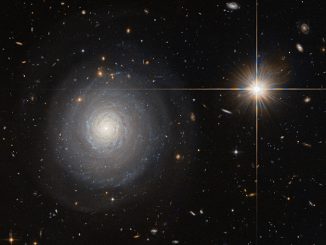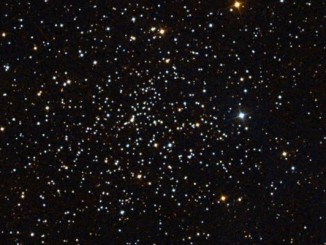
Advanced Camera for Surveys



A death star’s ghostly glow
The eerie glow of a dead star, which exploded long ago as a supernova, reveals itself in this NASA Hubble Space Telescope image of the Crab Nebula in the constellation of Taurus. But don’t be fooled. The ghoulish-looking object still has a pulse. Buried at its centre is the star’s telltale heart — a neutron star which beats with rhythmic precision.

Hubble reveals NGC 299 within the Small Magellanic Cloud
It may be famous for hosting the Small Magellanic Cloud (SMC) and 47 Tucanae, the second brightest globular cluster in the night sky, but the southern constellation of Tucana (The Toucan) also possesses a variety of unsung cosmic beauties. One such beauty is NGC 299, an open star cluster located within the SMC just under 200,000 light-years away.

The hidden dark side of spiral galaxy NGC 24
This glorious spiral galaxy is known as NGC 24, measures some 40,000 light-years across and lies about 25 million light-years away in the southern constellation of Sculptor. However, there may be more to this picture than first meets the eye: 80 percent of NGC 24’s mass is thought to be held within an invisible dark matter halo.

Hubble views starbirth in an irregular galaxy
This NASA/ESA Hubble Space Telescope image captures the glow of distant stars within NGC 5264, a dwarf galaxy located just over 15 million light-years away in the constellation of Hydra (The Sea Serpent). NGC 5264 clearly possesses an irregular shape — unlike the more common spiral or elliptical galaxies — with knots of blue star formation.

Hubble sees a lonely starburst galaxy
This NASA/ESA Hubble Space Telescope image shows an isolated starburst galaxy named MCG+07-33-027. The galaxy lies some 300 million light-years away from us, and is currently experiencing an extraordinarily high rate of star formation — a starburst. Normal galaxies produce only a couple of new stars per year, but starburst galaxies can produce a hundred times more than that!

Hubble dares to look into Pandora’s Box
Peering deep into the early universe, this picturesque parallel field observation from the NASA/ESA Hubble Space Telescope reveals thousands of colourful galaxies swimming in the inky blackness of space in the constellation Sculptor. This spectacular skyscape was captured during the study of the giant galaxy cluster Abell 2744, otherwise known as Pandora’s Box.

Astronomer solves mystery of ‘born again’ stars with Hubble
University of Texas astronomer Natalie Gosnell has used the Hubble Space Telescope to better understand why some stars aren’t evolving as predicted. These so-called “blue stragglers” look hotter and bluer than they should for their advanced age. It’s almost as it they were somehow reinvigorated to look much younger than they really are.

Hubble resolves youthful globular cluster NGC 1783
This Hubble Space Telescope image shows globular cluster NGC 1783 in the Southern Hemisphere constellation of Dorado. NGC 1783 lies within the Large Magellanic Cloud, a satellite galaxy of our Milky Way, some 160,000 light-years from Earth. NGC 1783 is thought to be less than 1.5 billion years old — very young for a globular cluster.
